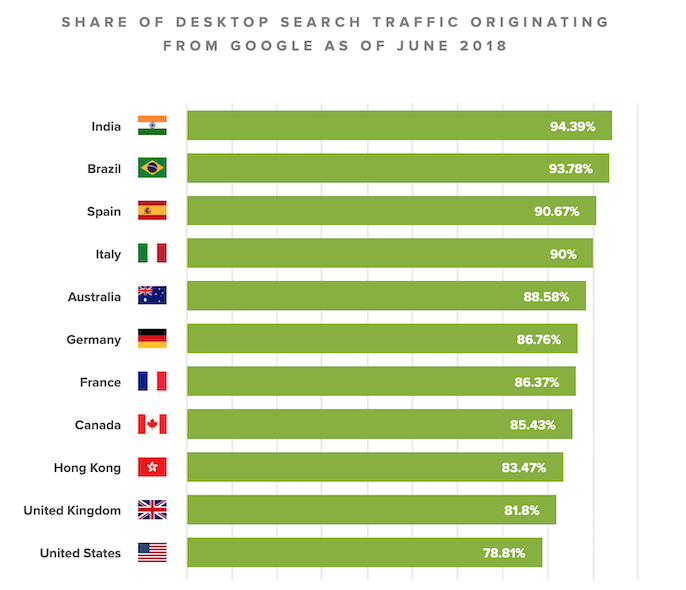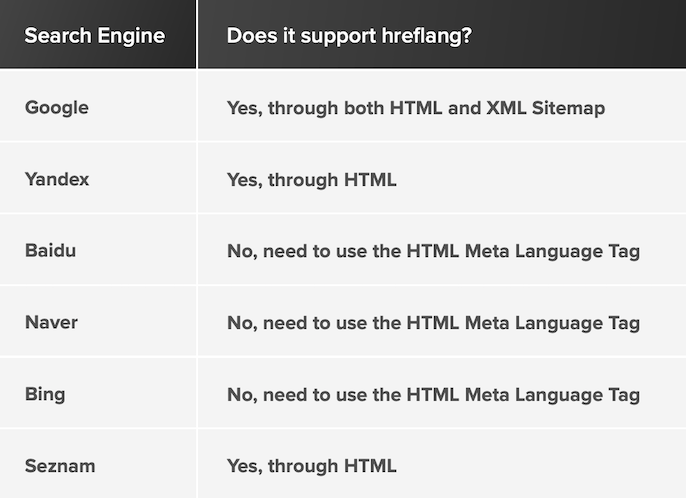Business growth depends on market opportunity, so strategies often move towards internationalisation in order to tap into multiple markets to exponentially increase these opportunities.
Access the PDF version of this guide
Thinking about Google organic search in particular as a means of reaching new customers, there is huge potential. If you can orchestrate a winning international SEO strategy and get your website ranking in different countries, your site is suddenly opened up to an additional surge of users. Take India as an example: the country has a population of around 1.2 billion, and 94% of all of its desktop search traffic comes from Google alone. That’s an enormous market share.

Image source: Statista
This is why thought, planning and attention to detail all need to feed into a sound internationalisation strategy in order to achieve global success. Internationalisation isn’t achieved overnight, however, and can be one of the most difficult aspects of SEO to get right, especially when you think about the language considerations and technical implementation required. That’s why we created this guide to share best practice knowledge and advice to help search marketers get to grips with the key concepts of internationalisation, the mistakes to look out for and how to get it all right for your business.
Going global: Considerations for users
If a business has a marketing strategy and infrastructure that’s working successfully in one particular language or territory and wants to replicate that success in other markets, we already have a problem. Digital marketing efforts can’t simply be replicated across different countries, each market and its population have unique considerations.
The biggest mistake websites make when it comes to internationalisation is to do it half-heartedly. Many website owners think that duplicating a site in English and aiming it at a country where they speak a different language is a perfectly valid approach to doing international business online. I cannot begin to explain just how wrong this approach is.
The key to successful internationalisation on the web is to go all out: every international presence you have needs to be as thoroughly optimised for that country and language as possible. Anything less than that will be immediately evident to the people you’re trying to target. Nobody likes to do business with a website that doesn’t take the effort to understand and communicate with its customers. For example, whenever someone arrives on your Spanish-language section, they should feel as if your business is a native Spanish entity, with every aspect of that section perfectly localised; from professional translations to currencies and shipping options.
While the web allows you to do business across the globe, that doesn’t mean you can cheat your way there. It still takes a lot of effort to become a global business, and if you’re not prepared to put in the effort you shouldn’t even try.

Users should sit at the centre of any international SEO strategy, meaning that you will have to tailor your efforts to each individual market and audience.
Language considerations
You have to truly understand the nuances of new audiences, the countries they’re from and the languages they speak in order to reach them. Detailed keyword and market research is essential for identifying the vocabulary that users from a location are actually searching with, which will help you talk to your users in the way they expect to be spoken to.
It may be necessary to consider going even further than generically targeting languages; for example, splitting up your strategy into English, French and Spanish might not be effective enough. People in Argentina and Mexico may speak Spanish, but that doesn’t mean they speak the language in the same way as people from Spain. Every country will have its own unique language considerations and nuances to be aware of.
There are variations in structure to consider as well as just the words of a language. You need to understand how your users read and digest content in their language. A left-to-right, horizontal page layout that works for an English speaker won’t work for someone who speaks Hebrew, which reads right to left, or for someone who speaks Japanese, which reads vertically.
If the language that you’re serving to a user isn’t truly talking to them, then you lose audience trust and potential conversion opportunities.
Cultural considerations
There are different search implications driven by culture as well as language, which affects the balance of search intent of people across the world. For example, seasonality plays a part in user behaviour, particularly when thinking about holiday months and buying behaviour over the year. A winter promotion for the US won’t apply to Australia who will be experiencing their summer.
There are additional complexities which add to our marketing efforts when you consider that many different languages are spoken across the different countries. Blanket targeting the UK with an English language site doesn’t reflect a multicultural reality. The main foreign languages spoken in the UK are French (23%), German (9%) and Spanish (8%), for example. Take the time to understand the percentages of languages spoken within each target market.
A person’s physical location doesn’t reflect their culture and identity, this is why blanket regional targeting isn’t the most effective approach.
International SEO success is all about examining and understanding the local target audience. Every region is unique; people search differently, they see images and colors differently, and they require different approaches and messaging. Simplicity is key. The more you complicate the user experience, the more abandoned conversions you’re going to get. In other words – think users first, think global next. Google will be drawn to the best UX.

As well as taking into consideration a user’s language and culture, you also need to be mindful of their browsing conditions and how they are able to access content. International success depends on reaching users quickly across their different devices.
If you want to be international, you’d better be mobile first and mobile fast. In the United States, 41% of total web traffic comes from mobile devices. For Asian markets, that share jumps to over 65%. 4G isn’t worldwide and for many international users, there’s a real monetary value attached to every MB. Can you imagine having to pay $5 every time a site decided you really needed to see their hero image? These users need lightweight experiences that adapt. Use Lighthouse to test your site and ensure you can meet users’ needs on slower networks.

Take a look at our previous guides on mobile and site speed to learn more about how to better optimise your website for your users.
Going global: Considerations for search engines
One of the most important things for search engines with regard to internationalisation is that you provide the strongest geolocation signals possible. Search engines can do their best to figure out your site’s international setup without full implementation on your end, as the team at Google explains:
Note that even without taking action, Google might still find alternate language versions of your page, but it is usually best for you to explicitly indicate your language or region-specific pages.
–Google Search Console Help
It’s good to know that Google provides a safety net, however, you should still do your best to adhere to its guidelines so you can be sure the right versions of your pages are actually being shown in the SERPs. Here are Google’s top 5 pieces of advice on managing different language versions of a website:
“Use different URLs for different language versions” – Use URLs to differentiate the language being served, instead of cookies, geographic location or browser settings.
“Make sure the page language is obvious” – Visible content is used to determine a page’s language, so help Google by using a single language on a page.
“Let the user switch the page language” – Give users a choice around the language they see, as geotargeting isn’t always perfect.
“Use language-specific URLs” – Localised words can be used in URLs as long as they use UTF-8 encoding and are escaped properly, although this can make hreflang implementation significantly more complicated to implement.
“Tell Google about your different language versions” – Mark your pages appropriately so Google knows which page corresponds to which language.
–Google Search Console Help
Googlebot crawls from California for the most part and uses a US IP address. This is essential to bear in mind if you have dynamically-generated content based on a user’s location, or if you block IP addresses from certain countries. If a website can only be viewed in a country outside the US, Google wouldn’t be able to crawl and index it, meaning the site won’t rank anywhere.
Blocking US IPs is likely to block Googlebot. Having at least some US-accessible content is recommended.
-John Mueller, Google Webmaster Hangout
Having multiple languages on the same page can confuse search engines and make it harder for them to understand if a page is relevant to a particular audience. For example, if you have a mix of French and English content on a page, Google may not see it as a true French or English result and it may not be shown for either language. Use a single language per page where possible and use hreflang to connect page variations to make things as clear as possible.
Only have one language on a page to ensure it will appear in search.
-John Mueller, Google Webmaster Hangout
Search engines need access to content and consistent signals in order to correctly show the right international website versions in the right international SERPs.
How other search engines handle internationalisation
Google isn’t the only search engine to consider, especially in international search. Each one handles internationalisation differently; what works for Google may not work for the others. This table by Dan Taylor, Account Director at SALT.agency, lays out how each search engine handles hreflang:

Source: Search Engine Journal
HTML language tags are the best solution for international targeting with Bing, Baidu and Naver because they don’t support hreflang tags. Here’s how you can tell Bing about your page variations:
- Embed metadata into the document using “content-language” in the <head>.
<meta http-equiv=”content-language” content=”en-us”>
- Include it in the <html> or <title> tags.
<html lang=”en-us”>
<title lang=”en-us”>
- Set the “content-language” in the HTTP header.
HTTP/1.1
…
Content-Language: en
Search engines handle internationalisation differently, so make sure you read up on the considerations for the ones you primarily want to appear in.
Chapter 2: The Most Common Mistakes in International SEO

